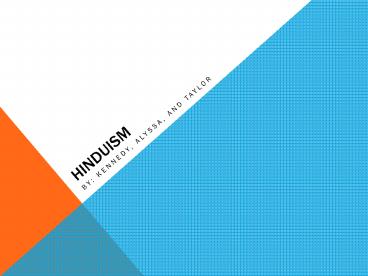Hinduism - PowerPoint PPT Presentation
1 / 18
Title:
Hinduism
Description:
HINDUISM BY: KENNEDY, ALYSSA, AND TAYLOR There is no specific founder but the one who received sacred text is Manu. Manu is considered the founder of tradition in ... – PowerPoint PPT presentation
Number of Views:257
Avg rating:3.0/5.0
Title: Hinduism
1
Hinduism
- BY Kennedy, Alyssa, and Taylor
2
Founders
- There is no specific founder but the one who
received sacred text is Manu. Manu is considered
the founder of tradition in Hinduism. Some say
that the founder of core philosophical beliefs
Shankara Acharya.
Shankara Acharya
Manu
3
Historical Context Of Founding
- BACK IN
- The Story
- 2000 B.C.
- There isnt an exact date for the beginning of
Hinduism but roughly 2000 B.C. is believed to
have been the beginning. The beginnings of
Hinduism are impossible to determine because it
has evolved so much.
4
SYMBOLS
The Bindi- it is a dot worn on womens foreheads.
Originally it was worn on married Hindu womens
foreheads to protect them and their husbands.
They were traditionally made of paste made of
sandalwood, sindoor, or turmeric. Now commonly
made with vermilion. It also is used to make a
third eye where the attention during meditation
is focused. Now bindi is also an accessory and is
worn by unmarried girls and non-Hindu women also.
The Swastika- is an important pictorial
character. It symbolizes eternal nature of
Brahman the Absolute because it points in all
directions. The term swastika is made of two
Sanskrit words Su meaning good and Asati
which means to exist. In ancient times forts were
built in the shape of a swastika for defense
reasons making it sanctified and protective.
The Saffron Color- this color reflects the color
of fire which reminds them of the Supreme Being.
The Hindu origin had fire worship festivals so
fire and its color are very important to them.
The Om- it is like the cross is to Christians. Om
is in every Hindu prayer. The symbol represents
the Absolute (the source of all existence)
5
Deities
- Brahma
- Considered the creator
- Not commonly worshipped
- Vishnu
- The Preserver
- Incarnated nine times
- Shiva
- The Destroyer or The Transformer
6
Location of Origin
- Hinduism is native to India in the Indus Valley
and from the Aryan race. This is the modern day
northeast Afghanistan to Pakistan and northwest
India.
7
Major Locations Today
- India, Nepal, and among the Tamils in SriLauka
are the largest locations of Hinduism currently.
8
Number of Followers
- About 50 million people are followers of Hinduism
About 14 of the worlds population are Hindus.
9
How/ Why did the Religion spread?
- Hinduism spread as people travelled through or to
India as a trade route. - It was spread among India originally by nomadic
tribes, who all had similar beliefs, and Hinduism
was formed when they combined their beliefs.
10
Holy Book(s) or Other Important Text
- There are 4 main Hindu scriptures. They are the
Vedas, the Ramayana, the Mahabharata, and the
Puranas. The vedasis a collection of hymns
praising the Vedic gods. Veda means knowledge.
The Ramayana are long poems about Rama and Sita.
The Manabharata includes the Bhagarad Gita. The
Paranas incarnations and the lives of saints.
11
Places of Worship
- Puja (worship) takes place in Mandir (temple).
Mandirs can be small village shrines to large
buildings surrounded by walls people can visit
the Mandir at anytime to pray and participate in
bhanjans (religious songs). Peoples also worship
at home and often have a special room with a
shrine to particular gods.
- The largest Hindu temple is Angkor Wat. It is
820,000 m2 and is in Angkor, Cambodia. It was
built for king Suryavarman II in the 12th
century. It was his temple and the capitol city.
It is the best preserved Hindu place of worship
there. It is the worlds largest religious
building.
12
Role of Men/Women
- Men
- Women
- Men are often seen as the breadwinners of the
household. - They are also supposed to protect their wives,
mothers, and daughters. - Main participants in religious events.
- Women are left at home to take care of their
children and in-laws - Supposed to serve their husband.
- Not usually allowed to participate in major
religious events.
13
More on the roles of women
- Women are reliant on men their whole lives. As
children, they are protected by their fathers, as
adults, they are taken care of by their husbands,
and as widows their sons take care of them. - A womans karma is said to be reflected in her
husband, so widows are generally treated poorly.
14
Holy Sites and Why
Prayag, Haridwar, Nashik, and Ujjain are
considered holy places. All are in India.
15
Holidays
Kumbh Mela Holi Mahashivaratri Rama
Navami Krishna Jayanti Raksabandhana Ganesha-Cha
turthi (Ganesha Utsava) Dassera Navaratri Diwali
16
Major Beliefs
- Karma
- Reincarnation
- Dharma
- The Caste System
- The Manu
17
Influence on Art, Architecture, Etc
- Hinduism is rooted in very rich visual tradition.
They take pride in their paintings, sculptures,
rangoli patterns, and architecture
18
Sources
- http//www.patheos.com/Library/Hinduism.html
- http//hinduism.about.com/od/artculture/a/major_hi
ndu_symbols.htm - http//www.religionfacts.com/hinduism/things/bindi
.htm - http//wiki.answers.com/Q/When_was_Hinduism_Origin
atedslide1 - "Angkor Temple Guide". Angkor Temple Guide. 2008.
Retrieved 31 October 2010. - www.mapsofindia.com
- http//www.britannica.com/EBchecked/topic/266312/H
induism/8988/The-spread-of-Hinduism-in-Southeast-A
sia-and-the-Pacific































